The United Nations Charter and its Impact
VerifiedAdded on 2020/02/19
|11
|3497
|192
AI Summary
This assignment delves into the United Nations Charter, examining its historical context, key principles such as the Four Freedoms and the maintenance of international peace and security, and its role in shaping global norms and institutions. It analyzes the Charter's influence on addressing ethnopolitical conflicts, promoting democracy, fostering multilateralism, and evolving towards criminalization within international law. The assignment also considers the United States' position on the International Criminal Court and the UN Security Council's actions regarding it.
Contribute Materials
Your contribution can guide someone’s learning journey. Share your
documents today.

Introduction: The United Nations (UN) was instituted in 1945 as an international organization
with a view to ensure world peace. The UN had taken the place of the League of Nations as it
was unsuccessfulin preventingThe Great War. The United Nations was set up by 51 nations and
led by the Allied powers after the Second World War. Now the UN has 193 members. The
configuration of the UN echoes the geopolitical conditions present at the time of its origin. The
Security Council of the UN is the body that has the responsibility to enforce its decisions. It has
five permanent members, the United States, Russia, UK, China and France. In the beginning,
Russia and China were not themembers of the Security Council, but they took the place of the
Soviet Union and the Republic of China.
It can be said that the UN is an organization of nations that have been intended to avert the
incidents of war between nations, but this organization has struggled to deal with the issues of
civil and ethnic strife within the nations. Particularly after the end of Cold War, there has been a
shift in the trends in conflict from international to intra-national conflicts. Hence, nations are no
more the defining framework when itcomes to describing a conflict (Fasulo, 2003). The UN
Security Council, the enforcement tool of the UN had to deal with intra-State as well as non-state
threats by expanding the scope of jurisdiction even if questions have been raised regarding the
suitability of intervention by the UN in internal conflict situations (Kingsbury and Roberts, eds.
1994).
The United Nations still deals with the issues in context of relations between the states, although,
many times there are common problems within the states. Similarly there are several
governments that are part of the UN and other authoritarian regimes butthey had come to power
with a view to ensure world peace. The UN had taken the place of the League of Nations as it
was unsuccessfulin preventingThe Great War. The United Nations was set up by 51 nations and
led by the Allied powers after the Second World War. Now the UN has 193 members. The
configuration of the UN echoes the geopolitical conditions present at the time of its origin. The
Security Council of the UN is the body that has the responsibility to enforce its decisions. It has
five permanent members, the United States, Russia, UK, China and France. In the beginning,
Russia and China were not themembers of the Security Council, but they took the place of the
Soviet Union and the Republic of China.
It can be said that the UN is an organization of nations that have been intended to avert the
incidents of war between nations, but this organization has struggled to deal with the issues of
civil and ethnic strife within the nations. Particularly after the end of Cold War, there has been a
shift in the trends in conflict from international to intra-national conflicts. Hence, nations are no
more the defining framework when itcomes to describing a conflict (Fasulo, 2003). The UN
Security Council, the enforcement tool of the UN had to deal with intra-State as well as non-state
threats by expanding the scope of jurisdiction even if questions have been raised regarding the
suitability of intervention by the UN in internal conflict situations (Kingsbury and Roberts, eds.
1994).
The United Nations still deals with the issues in context of relations between the states, although,
many times there are common problems within the states. Similarly there are several
governments that are part of the UN and other authoritarian regimes butthey had come to power
Secure Best Marks with AI Grader
Need help grading? Try our AI Grader for instant feedback on your assignments.
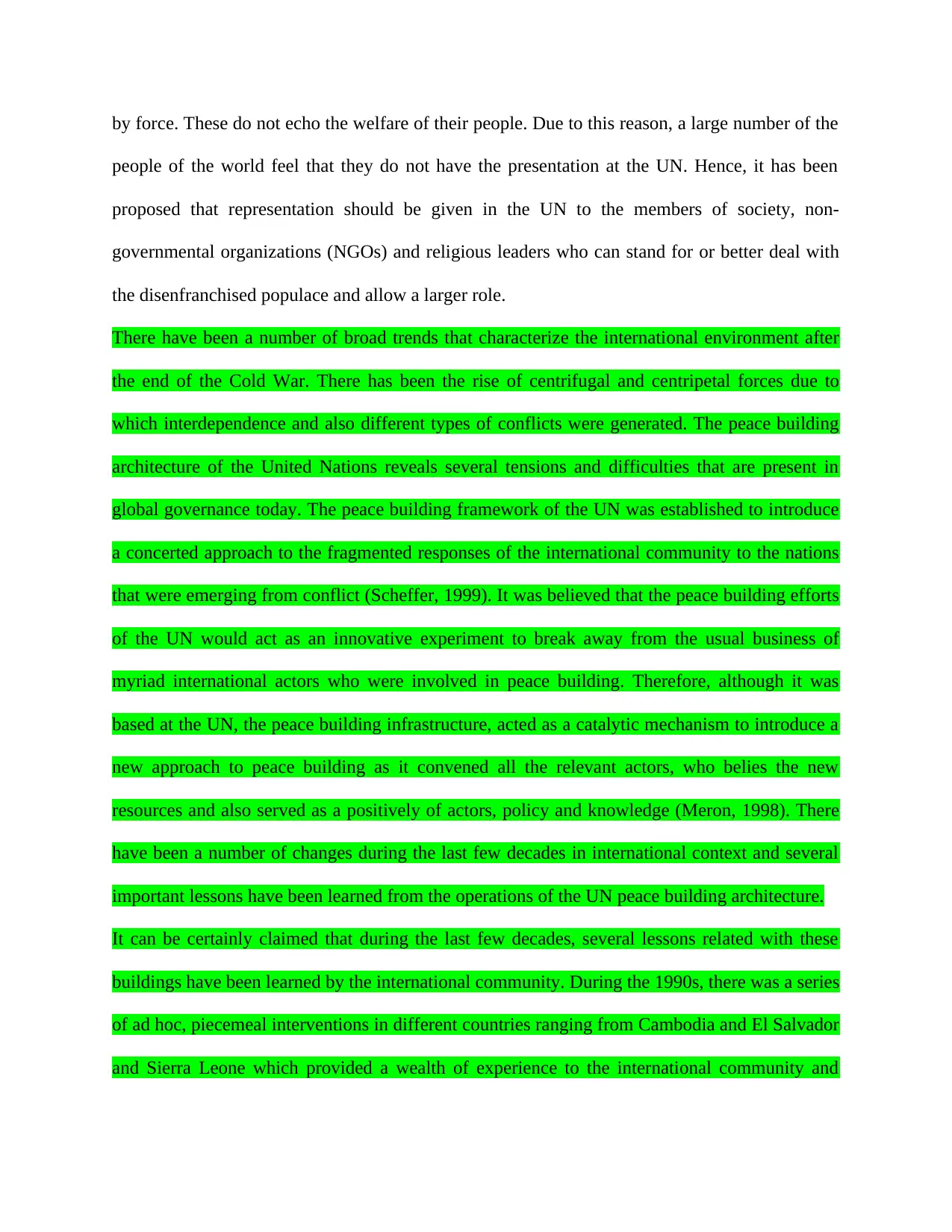
by force. These do not echo the welfare of their people. Due to this reason, a large number of the
people of the world feel that they do not have the presentation at the UN. Hence, it has been
proposed that representation should be given in the UN to the members of society, non-
governmental organizations (NGOs) and religious leaders who can stand for or better deal with
the disenfranchised populace and allow a larger role.
There have been a number of broad trends that characterize the international environment after
the end of the Cold War. There has been the rise of centrifugal and centripetal forces due to
which interdependence and also different types of conflicts were generated. The peace building
architecture of the United Nations reveals several tensions and difficulties that are present in
global governance today. The peace building framework of the UN was established to introduce
a concerted approach to the fragmented responses of the international community to the nations
that were emerging from conflict (Scheffer, 1999). It was believed that the peace building efforts
of the UN would act as an innovative experiment to break away from the usual business of
myriad international actors who were involved in peace building. Therefore, although it was
based at the UN, the peace building infrastructure, acted as a catalytic mechanism to introduce a
new approach to peace building as it convened all the relevant actors, who belies the new
resources and also served as a positively of actors, policy and knowledge (Meron, 1998). There
have been a number of changes during the last few decades in international context and several
important lessons have been learned from the operations of the UN peace building architecture.
It can be certainly claimed that during the last few decades, several lessons related with these
buildings have been learned by the international community. During the 1990s, there was a series
of ad hoc, piecemeal interventions in different countries ranging from Cambodia and El Salvador
and Sierra Leone which provided a wealth of experience to the international community and
people of the world feel that they do not have the presentation at the UN. Hence, it has been
proposed that representation should be given in the UN to the members of society, non-
governmental organizations (NGOs) and religious leaders who can stand for or better deal with
the disenfranchised populace and allow a larger role.
There have been a number of broad trends that characterize the international environment after
the end of the Cold War. There has been the rise of centrifugal and centripetal forces due to
which interdependence and also different types of conflicts were generated. The peace building
architecture of the United Nations reveals several tensions and difficulties that are present in
global governance today. The peace building framework of the UN was established to introduce
a concerted approach to the fragmented responses of the international community to the nations
that were emerging from conflict (Scheffer, 1999). It was believed that the peace building efforts
of the UN would act as an innovative experiment to break away from the usual business of
myriad international actors who were involved in peace building. Therefore, although it was
based at the UN, the peace building infrastructure, acted as a catalytic mechanism to introduce a
new approach to peace building as it convened all the relevant actors, who belies the new
resources and also served as a positively of actors, policy and knowledge (Meron, 1998). There
have been a number of changes during the last few decades in international context and several
important lessons have been learned from the operations of the UN peace building architecture.
It can be certainly claimed that during the last few decades, several lessons related with these
buildings have been learned by the international community. During the 1990s, there was a series
of ad hoc, piecemeal interventions in different countries ranging from Cambodia and El Salvador
and Sierra Leone which provided a wealth of experience to the international community and

resulted in the creation of new policies, entities, as well as new programs and practices
(Robertson, 2002). Peace building was further institutionalized by the creation of peace building
architecture in 2005 at the UN. It also confirmed its significance, as a part of the repertoire of the
conflict management tools that are available with the UN to assist the nations in overcoming the
legacy of violent conflicts and also to stop their lapse or relapse in conflict.
As mentioned above, after the end of the Cold War, there was a new generation of peacekeeping
operations. These new situations required more robust peacekeeping operations, so that they can
effectively deal with intra-state conflicts. However, in 1990s, UN was facing difficulties in
achieving this objective, which changed the initial optimism towards a more pessimistic position.
The complexity related with intra-state conflicts that were going on within the population of the
country, along with the governments and significant managerial problems, needed
multidimensional peacekeeping missions. This was the decade when interventions in different
states in conflict have been justified as the humanitarian intervention (Bassiouni, 1998).
The peacekeeping operations that took place during this time left and negative trace - Bosnia,
Rwanda, Somalia etc. As a result of the rarely successful peacekeeping operations of the UN, the
organization are to consider introducing major changes in the peace operations structure. As a
result of lack of consistency and determination of the mandate was not sustainable anymore.
Secretary-General Kofi Annan said that peace operations are meant to intervene: to prevent
conflict where we can, to put a stop to it when it has broken out, or -when neither of those things
is possible- at least to contain it and prevent it from spreading. The results of this change in
perspective can be seen in the form of UN mandates in Sierra Leone and in Haiti.
(Robertson, 2002). Peace building was further institutionalized by the creation of peace building
architecture in 2005 at the UN. It also confirmed its significance, as a part of the repertoire of the
conflict management tools that are available with the UN to assist the nations in overcoming the
legacy of violent conflicts and also to stop their lapse or relapse in conflict.
As mentioned above, after the end of the Cold War, there was a new generation of peacekeeping
operations. These new situations required more robust peacekeeping operations, so that they can
effectively deal with intra-state conflicts. However, in 1990s, UN was facing difficulties in
achieving this objective, which changed the initial optimism towards a more pessimistic position.
The complexity related with intra-state conflicts that were going on within the population of the
country, along with the governments and significant managerial problems, needed
multidimensional peacekeeping missions. This was the decade when interventions in different
states in conflict have been justified as the humanitarian intervention (Bassiouni, 1998).
The peacekeeping operations that took place during this time left and negative trace - Bosnia,
Rwanda, Somalia etc. As a result of the rarely successful peacekeeping operations of the UN, the
organization are to consider introducing major changes in the peace operations structure. As a
result of lack of consistency and determination of the mandate was not sustainable anymore.
Secretary-General Kofi Annan said that peace operations are meant to intervene: to prevent
conflict where we can, to put a stop to it when it has broken out, or -when neither of those things
is possible- at least to contain it and prevent it from spreading. The results of this change in
perspective can be seen in the form of UN mandates in Sierra Leone and in Haiti.

“With growing awareness that a new problem is serious enough to warrant attention by the
international policy community of states, new norms in which the newly acquired knowledge is
embedded need to be articulated, disseminated, and institutionalized (Thakur and Weiss, 2009).
Peacekeeping is a complicated concept that has complicated uses. As a result of the difficult
coordination that exists in the political sphere - the UN, secretary general, Security Council and
member states and also in the operational sphere, the type of conflict, parties confronted and
geographical area, the required distance he was not present that was necessary. For these
operations to be effective. The problems start with the fact that there is no definition of
peacekeeping, mentioned in the charter of the UN. There is no particular Article of the chapter
that precisely refers to the meaning of peacekeeping operations or the criteria to establish these
operations or the guidelines related with the deployment of these operations. Secretary-General
Boutros-Ghali had stated that the peace operations entail the deployment of the UN in the field,
hitherto with the consent of all the parties concerned and for the purpose of ending the conflict
and to recover security in the area (Weller, 2002). Therefore, it can be said that the objective of
peacekeeping forces is to protect the civilians, supervise the cease-fire, provide aid, ensure the
demobilization of military and elections so that the particular nation can be restored back to
peace and stability.
Annan had identified five policy pillars of a counterterrorism strategy. These were “dissuasion of
people from resorting to or supporting terrorism; denial of access to funds and materials to
terrorists; deterrence of states from sponsoring terrorism; capacity development so states can
defeat terrorism; and defense of human rights.” (Thakur and Weiss, 2009).
international policy community of states, new norms in which the newly acquired knowledge is
embedded need to be articulated, disseminated, and institutionalized (Thakur and Weiss, 2009).
Peacekeeping is a complicated concept that has complicated uses. As a result of the difficult
coordination that exists in the political sphere - the UN, secretary general, Security Council and
member states and also in the operational sphere, the type of conflict, parties confronted and
geographical area, the required distance he was not present that was necessary. For these
operations to be effective. The problems start with the fact that there is no definition of
peacekeeping, mentioned in the charter of the UN. There is no particular Article of the chapter
that precisely refers to the meaning of peacekeeping operations or the criteria to establish these
operations or the guidelines related with the deployment of these operations. Secretary-General
Boutros-Ghali had stated that the peace operations entail the deployment of the UN in the field,
hitherto with the consent of all the parties concerned and for the purpose of ending the conflict
and to recover security in the area (Weller, 2002). Therefore, it can be said that the objective of
peacekeeping forces is to protect the civilians, supervise the cease-fire, provide aid, ensure the
demobilization of military and elections so that the particular nation can be restored back to
peace and stability.
Annan had identified five policy pillars of a counterterrorism strategy. These were “dissuasion of
people from resorting to or supporting terrorism; denial of access to funds and materials to
terrorists; deterrence of states from sponsoring terrorism; capacity development so states can
defeat terrorism; and defense of human rights.” (Thakur and Weiss, 2009).
Secure Best Marks with AI Grader
Need help grading? Try our AI Grader for instant feedback on your assignments.
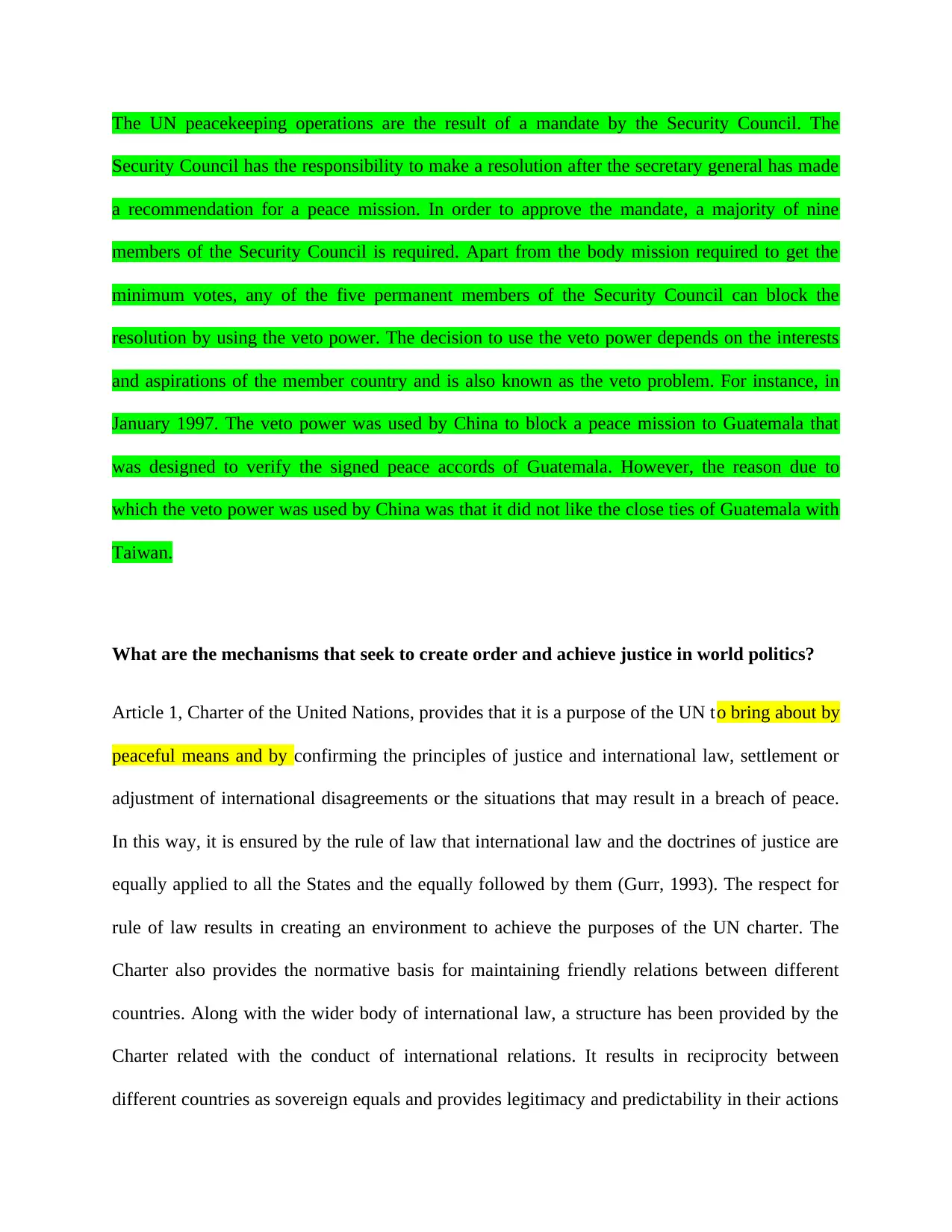
The UN peacekeeping operations are the result of a mandate by the Security Council. The
Security Council has the responsibility to make a resolution after the secretary general has made
a recommendation for a peace mission. In order to approve the mandate, a majority of nine
members of the Security Council is required. Apart from the body mission required to get the
minimum votes, any of the five permanent members of the Security Council can block the
resolution by using the veto power. The decision to use the veto power depends on the interests
and aspirations of the member country and is also known as the veto problem. For instance, in
January 1997. The veto power was used by China to block a peace mission to Guatemala that
was designed to verify the signed peace accords of Guatemala. However, the reason due to
which the veto power was used by China was that it did not like the close ties of Guatemala with
Taiwan.
What are the mechanisms that seek to create order and achieve justice in world politics?
Article 1, Charter of the United Nations, provides that it is a purpose of the UN to bring about by
peaceful means and by confirming the principles of justice and international law, settlement or
adjustment of international disagreements or the situations that may result in a breach of peace.
In this way, it is ensured by the rule of law that international law and the doctrines of justice are
equally applied to all the States and the equally followed by them (Gurr, 1993). The respect for
rule of law results in creating an environment to achieve the purposes of the UN charter. The
Charter also provides the normative basis for maintaining friendly relations between different
countries. Along with the wider body of international law, a structure has been provided by the
Charter related with the conduct of international relations. It results in reciprocity between
different countries as sovereign equals and provides legitimacy and predictability in their actions
Security Council has the responsibility to make a resolution after the secretary general has made
a recommendation for a peace mission. In order to approve the mandate, a majority of nine
members of the Security Council is required. Apart from the body mission required to get the
minimum votes, any of the five permanent members of the Security Council can block the
resolution by using the veto power. The decision to use the veto power depends on the interests
and aspirations of the member country and is also known as the veto problem. For instance, in
January 1997. The veto power was used by China to block a peace mission to Guatemala that
was designed to verify the signed peace accords of Guatemala. However, the reason due to
which the veto power was used by China was that it did not like the close ties of Guatemala with
Taiwan.
What are the mechanisms that seek to create order and achieve justice in world politics?
Article 1, Charter of the United Nations, provides that it is a purpose of the UN to bring about by
peaceful means and by confirming the principles of justice and international law, settlement or
adjustment of international disagreements or the situations that may result in a breach of peace.
In this way, it is ensured by the rule of law that international law and the doctrines of justice are
equally applied to all the States and the equally followed by them (Gurr, 1993). The respect for
rule of law results in creating an environment to achieve the purposes of the UN charter. The
Charter also provides the normative basis for maintaining friendly relations between different
countries. Along with the wider body of international law, a structure has been provided by the
Charter related with the conduct of international relations. It results in reciprocity between
different countries as sovereign equals and provides legitimacy and predictability in their actions
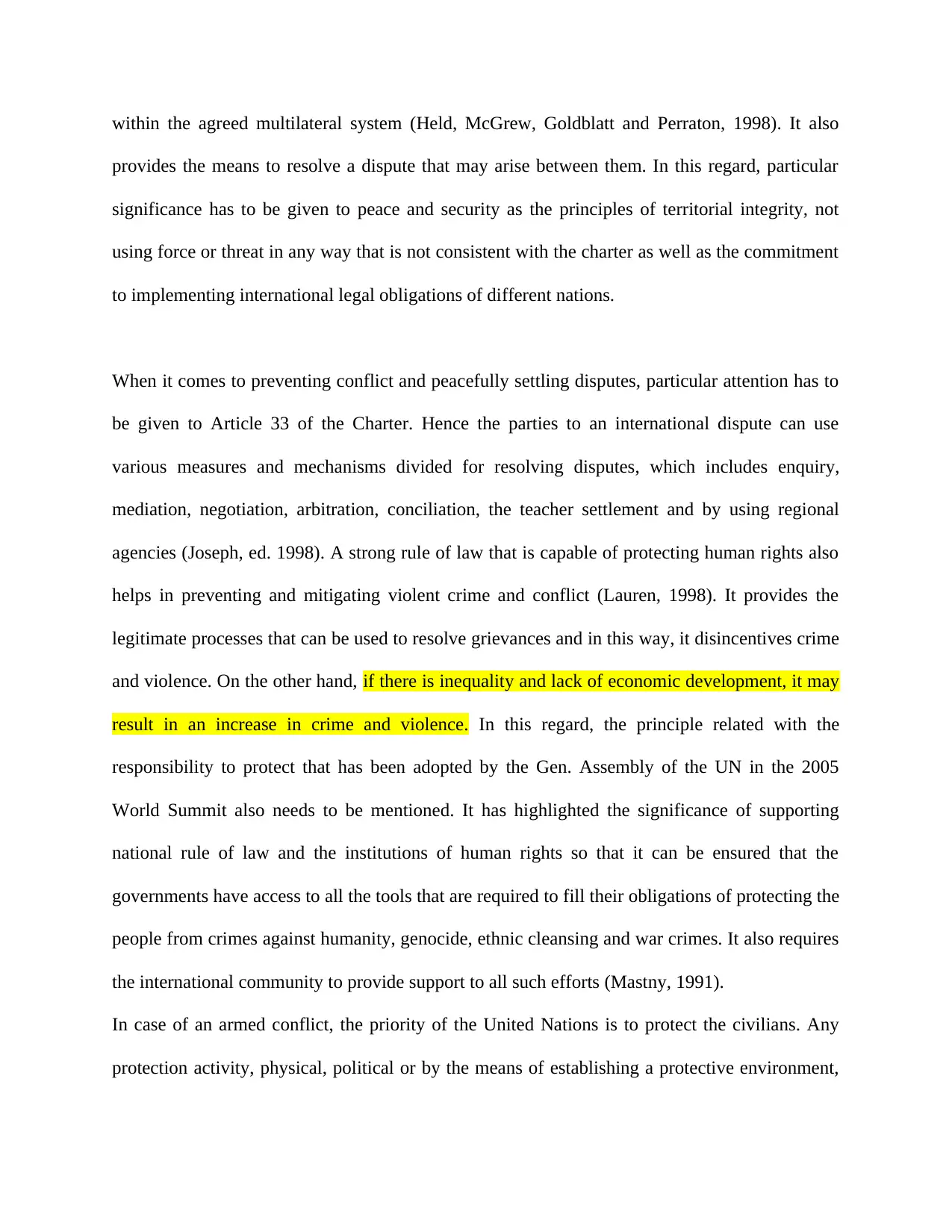
within the agreed multilateral system (Held, McGrew, Goldblatt and Perraton, 1998). It also
provides the means to resolve a dispute that may arise between them. In this regard, particular
significance has to be given to peace and security as the principles of territorial integrity, not
using force or threat in any way that is not consistent with the charter as well as the commitment
to implementing international legal obligations of different nations.
When it comes to preventing conflict and peacefully settling disputes, particular attention has to
be given to Article 33 of the Charter. Hence the parties to an international dispute can use
various measures and mechanisms divided for resolving disputes, which includes enquiry,
mediation, negotiation, arbitration, conciliation, the teacher settlement and by using regional
agencies (Joseph, ed. 1998). A strong rule of law that is capable of protecting human rights also
helps in preventing and mitigating violent crime and conflict (Lauren, 1998). It provides the
legitimate processes that can be used to resolve grievances and in this way, it disincentives crime
and violence. On the other hand, if there is inequality and lack of economic development, it may
result in an increase in crime and violence. In this regard, the principle related with the
responsibility to protect that has been adopted by the Gen. Assembly of the UN in the 2005
World Summit also needs to be mentioned. It has highlighted the significance of supporting
national rule of law and the institutions of human rights so that it can be ensured that the
governments have access to all the tools that are required to fill their obligations of protecting the
people from crimes against humanity, genocide, ethnic cleansing and war crimes. It also requires
the international community to provide support to all such efforts (Mastny, 1991).
In case of an armed conflict, the priority of the United Nations is to protect the civilians. Any
protection activity, physical, political or by the means of establishing a protective environment,
provides the means to resolve a dispute that may arise between them. In this regard, particular
significance has to be given to peace and security as the principles of territorial integrity, not
using force or threat in any way that is not consistent with the charter as well as the commitment
to implementing international legal obligations of different nations.
When it comes to preventing conflict and peacefully settling disputes, particular attention has to
be given to Article 33 of the Charter. Hence the parties to an international dispute can use
various measures and mechanisms divided for resolving disputes, which includes enquiry,
mediation, negotiation, arbitration, conciliation, the teacher settlement and by using regional
agencies (Joseph, ed. 1998). A strong rule of law that is capable of protecting human rights also
helps in preventing and mitigating violent crime and conflict (Lauren, 1998). It provides the
legitimate processes that can be used to resolve grievances and in this way, it disincentives crime
and violence. On the other hand, if there is inequality and lack of economic development, it may
result in an increase in crime and violence. In this regard, the principle related with the
responsibility to protect that has been adopted by the Gen. Assembly of the UN in the 2005
World Summit also needs to be mentioned. It has highlighted the significance of supporting
national rule of law and the institutions of human rights so that it can be ensured that the
governments have access to all the tools that are required to fill their obligations of protecting the
people from crimes against humanity, genocide, ethnic cleansing and war crimes. It also requires
the international community to provide support to all such efforts (Mastny, 1991).
In case of an armed conflict, the priority of the United Nations is to protect the civilians. Any
protection activity, physical, political or by the means of establishing a protective environment,
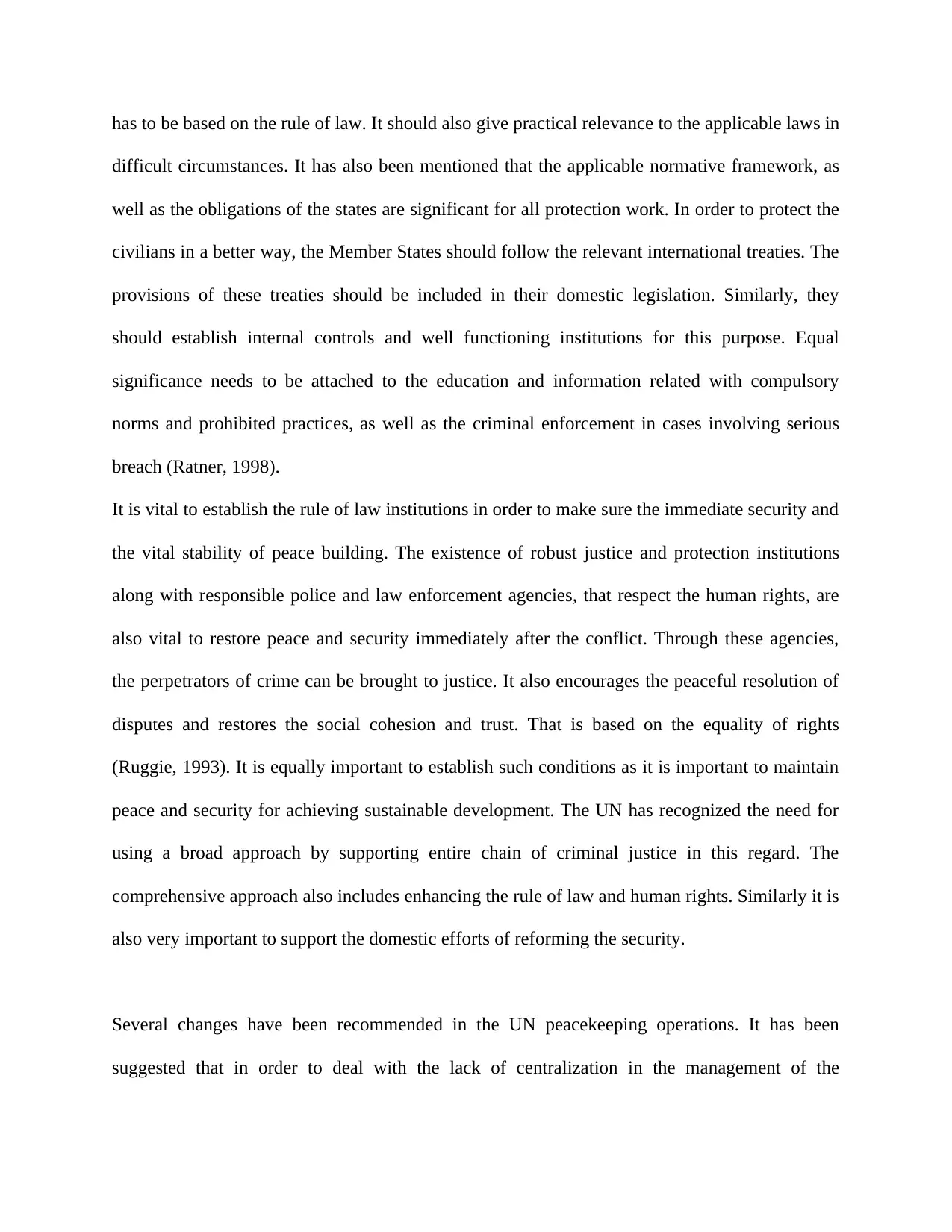
has to be based on the rule of law. It should also give practical relevance to the applicable laws in
difficult circumstances. It has also been mentioned that the applicable normative framework, as
well as the obligations of the states are significant for all protection work. In order to protect the
civilians in a better way, the Member States should follow the relevant international treaties. The
provisions of these treaties should be included in their domestic legislation. Similarly, they
should establish internal controls and well functioning institutions for this purpose. Equal
significance needs to be attached to the education and information related with compulsory
norms and prohibited practices, as well as the criminal enforcement in cases involving serious
breach (Ratner, 1998).
It is vital to establish the rule of law institutions in order to make sure the immediate security and
the vital stability of peace building. The existence of robust justice and protection institutions
along with responsible police and law enforcement agencies, that respect the human rights, are
also vital to restore peace and security immediately after the conflict. Through these agencies,
the perpetrators of crime can be brought to justice. It also encourages the peaceful resolution of
disputes and restores the social cohesion and trust. That is based on the equality of rights
(Ruggie, 1993). It is equally important to establish such conditions as it is important to maintain
peace and security for achieving sustainable development. The UN has recognized the need for
using a broad approach by supporting entire chain of criminal justice in this regard. The
comprehensive approach also includes enhancing the rule of law and human rights. Similarly it is
also very important to support the domestic efforts of reforming the security.
Several changes have been recommended in the UN peacekeeping operations. It has been
suggested that in order to deal with the lack of centralization in the management of the
difficult circumstances. It has also been mentioned that the applicable normative framework, as
well as the obligations of the states are significant for all protection work. In order to protect the
civilians in a better way, the Member States should follow the relevant international treaties. The
provisions of these treaties should be included in their domestic legislation. Similarly, they
should establish internal controls and well functioning institutions for this purpose. Equal
significance needs to be attached to the education and information related with compulsory
norms and prohibited practices, as well as the criminal enforcement in cases involving serious
breach (Ratner, 1998).
It is vital to establish the rule of law institutions in order to make sure the immediate security and
the vital stability of peace building. The existence of robust justice and protection institutions
along with responsible police and law enforcement agencies, that respect the human rights, are
also vital to restore peace and security immediately after the conflict. Through these agencies,
the perpetrators of crime can be brought to justice. It also encourages the peaceful resolution of
disputes and restores the social cohesion and trust. That is based on the equality of rights
(Ruggie, 1993). It is equally important to establish such conditions as it is important to maintain
peace and security for achieving sustainable development. The UN has recognized the need for
using a broad approach by supporting entire chain of criminal justice in this regard. The
comprehensive approach also includes enhancing the rule of law and human rights. Similarly it is
also very important to support the domestic efforts of reforming the security.
Several changes have been recommended in the UN peacekeeping operations. It has been
suggested that in order to deal with the lack of centralization in the management of the
Paraphrase This Document
Need a fresh take? Get an instant paraphrase of this document with our AI Paraphraser
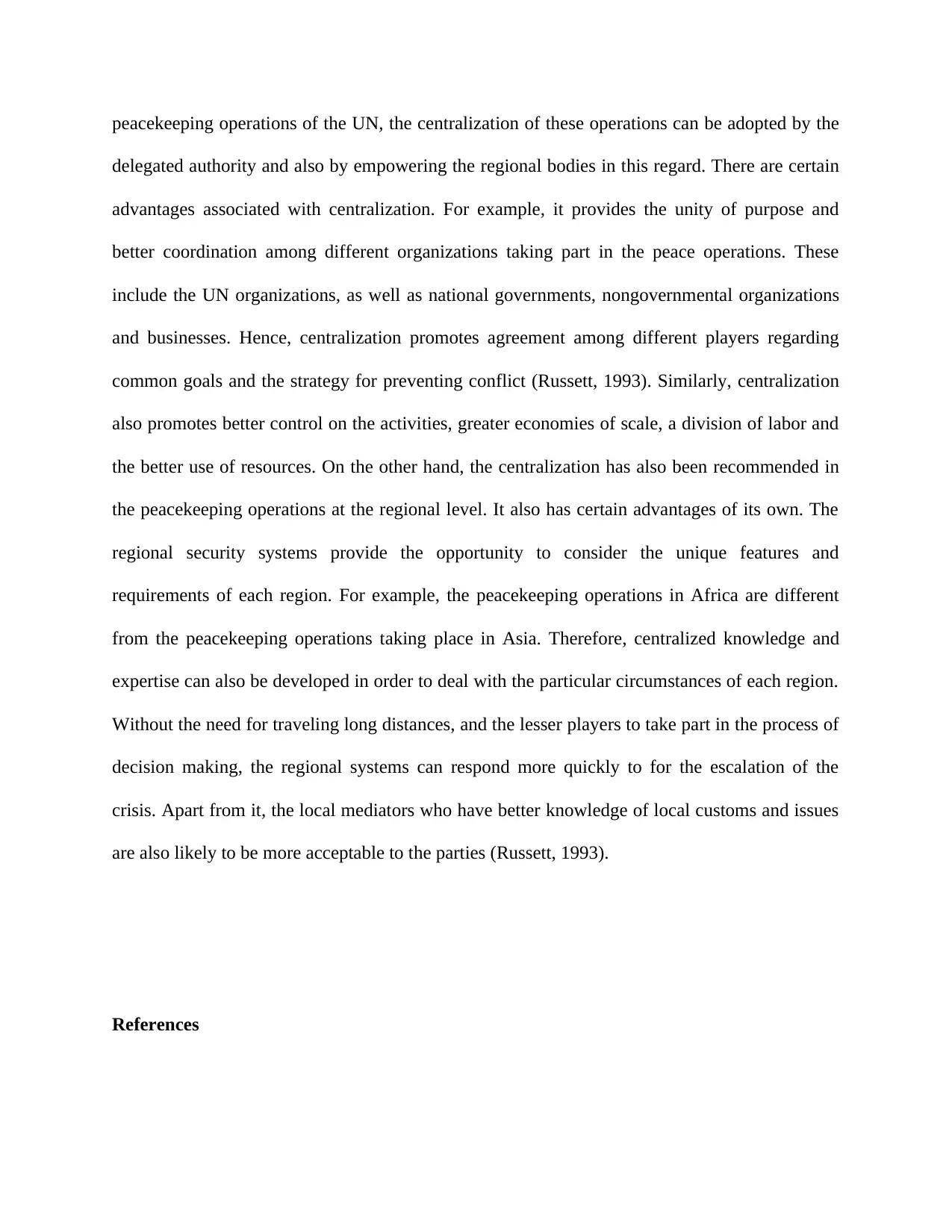
peacekeeping operations of the UN, the centralization of these operations can be adopted by the
delegated authority and also by empowering the regional bodies in this regard. There are certain
advantages associated with centralization. For example, it provides the unity of purpose and
better coordination among different organizations taking part in the peace operations. These
include the UN organizations, as well as national governments, nongovernmental organizations
and businesses. Hence, centralization promotes agreement among different players regarding
common goals and the strategy for preventing conflict (Russett, 1993). Similarly, centralization
also promotes better control on the activities, greater economies of scale, a division of labor and
the better use of resources. On the other hand, the centralization has also been recommended in
the peacekeeping operations at the regional level. It also has certain advantages of its own. The
regional security systems provide the opportunity to consider the unique features and
requirements of each region. For example, the peacekeeping operations in Africa are different
from the peacekeeping operations taking place in Asia. Therefore, centralized knowledge and
expertise can also be developed in order to deal with the particular circumstances of each region.
Without the need for traveling long distances, and the lesser players to take part in the process of
decision making, the regional systems can respond more quickly to for the escalation of the
crisis. Apart from it, the local mediators who have better knowledge of local customs and issues
are also likely to be more acceptable to the parties (Russett, 1993).
References
delegated authority and also by empowering the regional bodies in this regard. There are certain
advantages associated with centralization. For example, it provides the unity of purpose and
better coordination among different organizations taking part in the peace operations. These
include the UN organizations, as well as national governments, nongovernmental organizations
and businesses. Hence, centralization promotes agreement among different players regarding
common goals and the strategy for preventing conflict (Russett, 1993). Similarly, centralization
also promotes better control on the activities, greater economies of scale, a division of labor and
the better use of resources. On the other hand, the centralization has also been recommended in
the peacekeeping operations at the regional level. It also has certain advantages of its own. The
regional security systems provide the opportunity to consider the unique features and
requirements of each region. For example, the peacekeeping operations in Africa are different
from the peacekeeping operations taking place in Asia. Therefore, centralized knowledge and
expertise can also be developed in order to deal with the particular circumstances of each region.
Without the need for traveling long distances, and the lesser players to take part in the process of
decision making, the regional systems can respond more quickly to for the escalation of the
crisis. Apart from it, the local mediators who have better knowledge of local customs and issues
are also likely to be more acceptable to the parties (Russett, 1993).
References
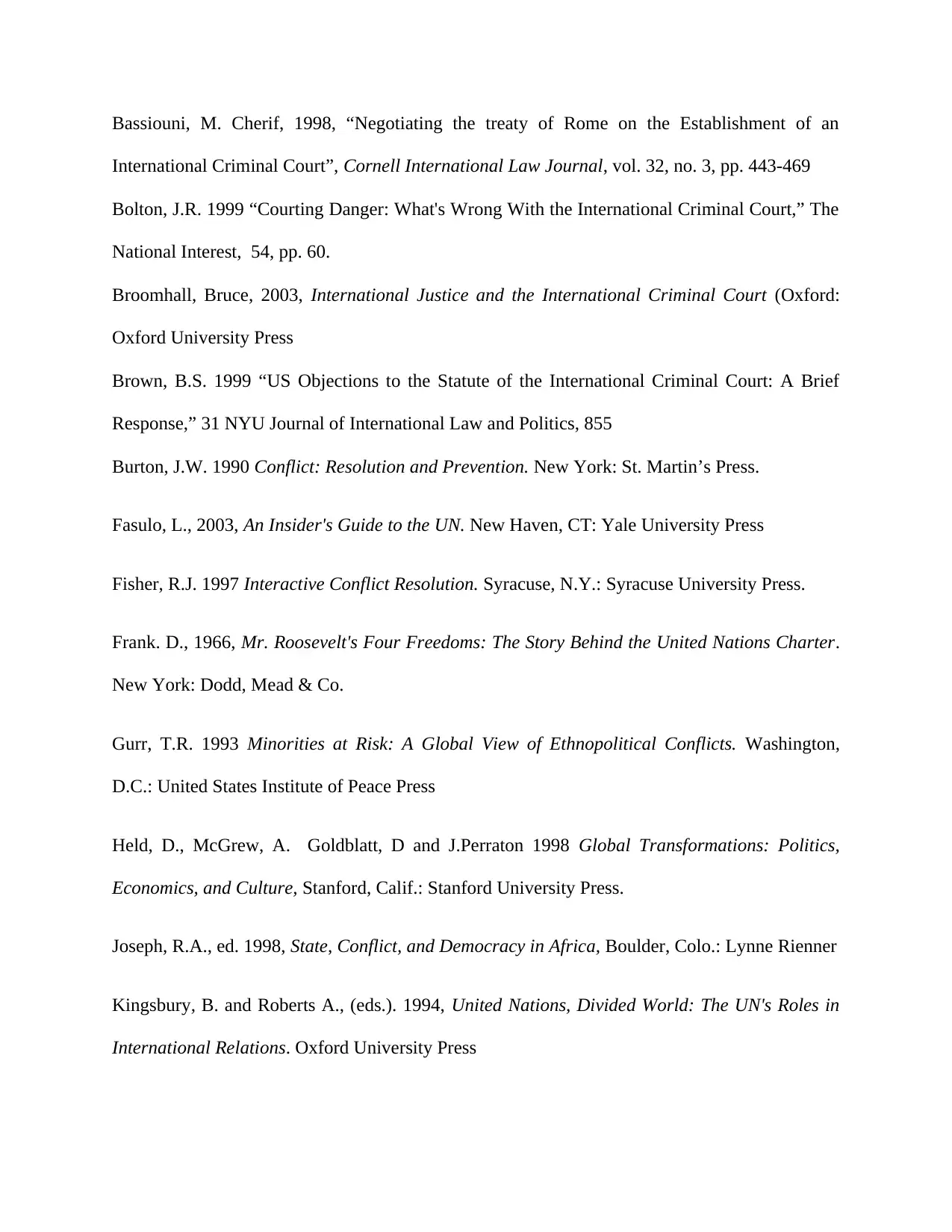
Bassiouni, M. Cherif, 1998, “Negotiating the treaty of Rome on the Establishment of an
International Criminal Court”, Cornell International Law Journal, vol. 32, no. 3, pp. 443-469
Bolton, J.R. 1999 “Courting Danger: What's Wrong With the International Criminal Court,” The
National Interest, 54, pp. 60.
Broomhall, Bruce, 2003, International Justice and the International Criminal Court (Oxford:
Oxford University Press
Brown, B.S. 1999 “US Objections to the Statute of the International Criminal Court: A Brief
Response,” 31 NYU Journal of International Law and Politics, 855
Burton, J.W. 1990 Conflict: Resolution and Prevention. New York: St. Martin’s Press.
Fasulo, L., 2003, An Insider's Guide to the UN. New Haven, CT: Yale University Press
Fisher, R.J. 1997 Interactive Conflict Resolution. Syracuse, N.Y.: Syracuse University Press.
Frank. D., 1966, Mr. Roosevelt's Four Freedoms: The Story Behind the United Nations Charter.
New York: Dodd, Mead & Co.
Gurr, T.R. 1993 Minorities at Risk: A Global View of Ethnopolitical Conflicts. Washington,
D.C.: United States Institute of Peace Press
Held, D., McGrew, A. Goldblatt, D and J.Perraton 1998 Global Transformations: Politics,
Economics, and Culture, Stanford, Calif.: Stanford University Press.
Joseph, R.A., ed. 1998, State, Conflict, and Democracy in Africa, Boulder, Colo.: Lynne Rienner
Kingsbury, B. and Roberts A., (eds.). 1994, United Nations, Divided World: The UN's Roles in
International Relations. Oxford University Press
International Criminal Court”, Cornell International Law Journal, vol. 32, no. 3, pp. 443-469
Bolton, J.R. 1999 “Courting Danger: What's Wrong With the International Criminal Court,” The
National Interest, 54, pp. 60.
Broomhall, Bruce, 2003, International Justice and the International Criminal Court (Oxford:
Oxford University Press
Brown, B.S. 1999 “US Objections to the Statute of the International Criminal Court: A Brief
Response,” 31 NYU Journal of International Law and Politics, 855
Burton, J.W. 1990 Conflict: Resolution and Prevention. New York: St. Martin’s Press.
Fasulo, L., 2003, An Insider's Guide to the UN. New Haven, CT: Yale University Press
Fisher, R.J. 1997 Interactive Conflict Resolution. Syracuse, N.Y.: Syracuse University Press.
Frank. D., 1966, Mr. Roosevelt's Four Freedoms: The Story Behind the United Nations Charter.
New York: Dodd, Mead & Co.
Gurr, T.R. 1993 Minorities at Risk: A Global View of Ethnopolitical Conflicts. Washington,
D.C.: United States Institute of Peace Press
Held, D., McGrew, A. Goldblatt, D and J.Perraton 1998 Global Transformations: Politics,
Economics, and Culture, Stanford, Calif.: Stanford University Press.
Joseph, R.A., ed. 1998, State, Conflict, and Democracy in Africa, Boulder, Colo.: Lynne Rienner
Kingsbury, B. and Roberts A., (eds.). 1994, United Nations, Divided World: The UN's Roles in
International Relations. Oxford University Press
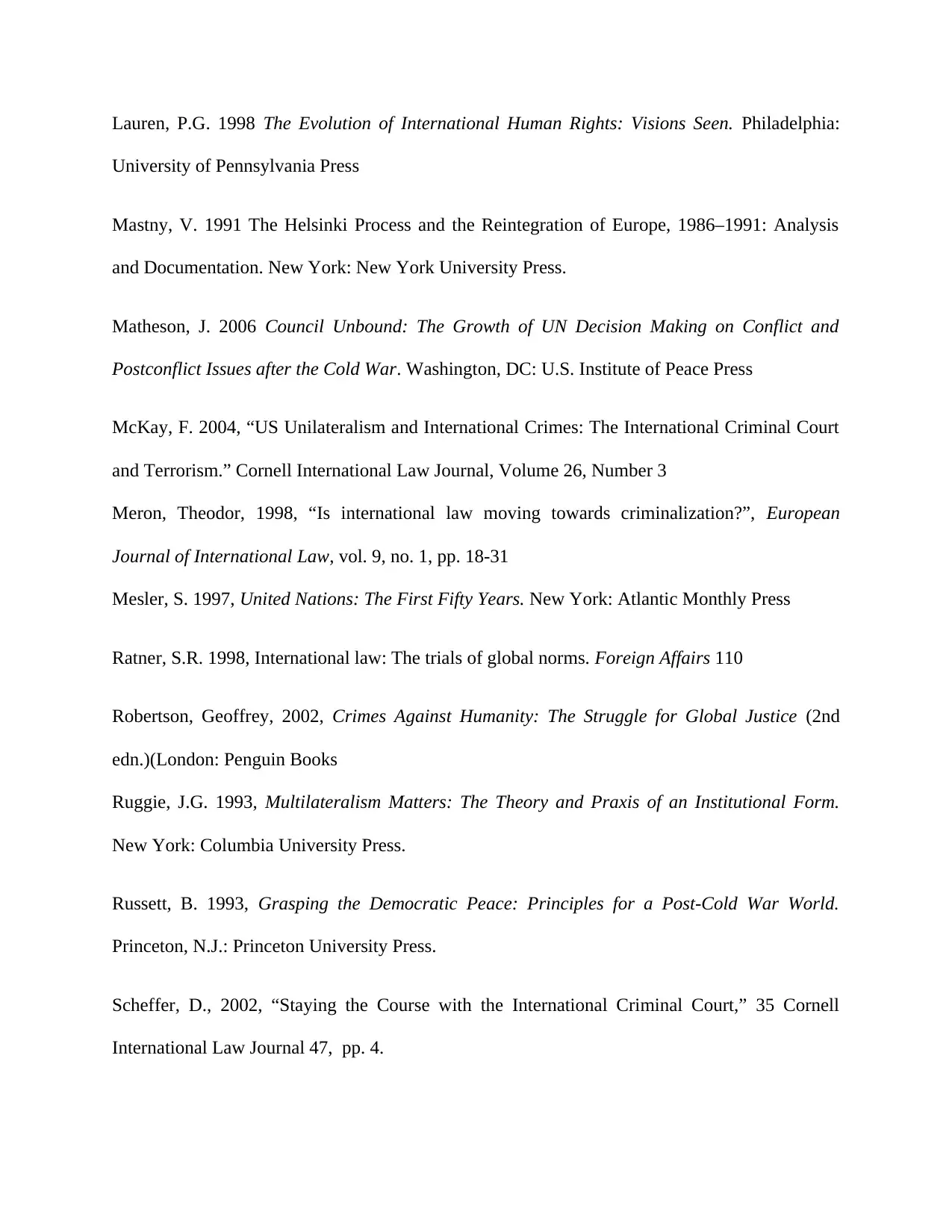
Lauren, P.G. 1998 The Evolution of International Human Rights: Visions Seen. Philadelphia:
University of Pennsylvania Press
Mastny, V. 1991 The Helsinki Process and the Reintegration of Europe, 1986–1991: Analysis
and Documentation. New York: New York University Press.
Matheson, J. 2006 Council Unbound: The Growth of UN Decision Making on Conflict and
Postconflict Issues after the Cold War. Washington, DC: U.S. Institute of Peace Press
McKay, F. 2004, “US Unilateralism and International Crimes: The International Criminal Court
and Terrorism.” Cornell International Law Journal, Volume 26, Number 3
Meron, Theodor, 1998, “Is international law moving towards criminalization?”, European
Journal of International Law, vol. 9, no. 1, pp. 18-31
Mesler, S. 1997, United Nations: The First Fifty Years. New York: Atlantic Monthly Press
Ratner, S.R. 1998, International law: The trials of global norms. Foreign Affairs 110
Robertson, Geoffrey, 2002, Crimes Against Humanity: The Struggle for Global Justice (2nd
edn.)(London: Penguin Books
Ruggie, J.G. 1993, Multilateralism Matters: The Theory and Praxis of an Institutional Form.
New York: Columbia University Press.
Russett, B. 1993, Grasping the Democratic Peace: Principles for a Post-Cold War World.
Princeton, N.J.: Princeton University Press.
Scheffer, D., 2002, “Staying the Course with the International Criminal Court,” 35 Cornell
International Law Journal 47, pp. 4.
University of Pennsylvania Press
Mastny, V. 1991 The Helsinki Process and the Reintegration of Europe, 1986–1991: Analysis
and Documentation. New York: New York University Press.
Matheson, J. 2006 Council Unbound: The Growth of UN Decision Making on Conflict and
Postconflict Issues after the Cold War. Washington, DC: U.S. Institute of Peace Press
McKay, F. 2004, “US Unilateralism and International Crimes: The International Criminal Court
and Terrorism.” Cornell International Law Journal, Volume 26, Number 3
Meron, Theodor, 1998, “Is international law moving towards criminalization?”, European
Journal of International Law, vol. 9, no. 1, pp. 18-31
Mesler, S. 1997, United Nations: The First Fifty Years. New York: Atlantic Monthly Press
Ratner, S.R. 1998, International law: The trials of global norms. Foreign Affairs 110
Robertson, Geoffrey, 2002, Crimes Against Humanity: The Struggle for Global Justice (2nd
edn.)(London: Penguin Books
Ruggie, J.G. 1993, Multilateralism Matters: The Theory and Praxis of an Institutional Form.
New York: Columbia University Press.
Russett, B. 1993, Grasping the Democratic Peace: Principles for a Post-Cold War World.
Princeton, N.J.: Princeton University Press.
Scheffer, D., 2002, “Staying the Course with the International Criminal Court,” 35 Cornell
International Law Journal 47, pp. 4.
Secure Best Marks with AI Grader
Need help grading? Try our AI Grader for instant feedback on your assignments.
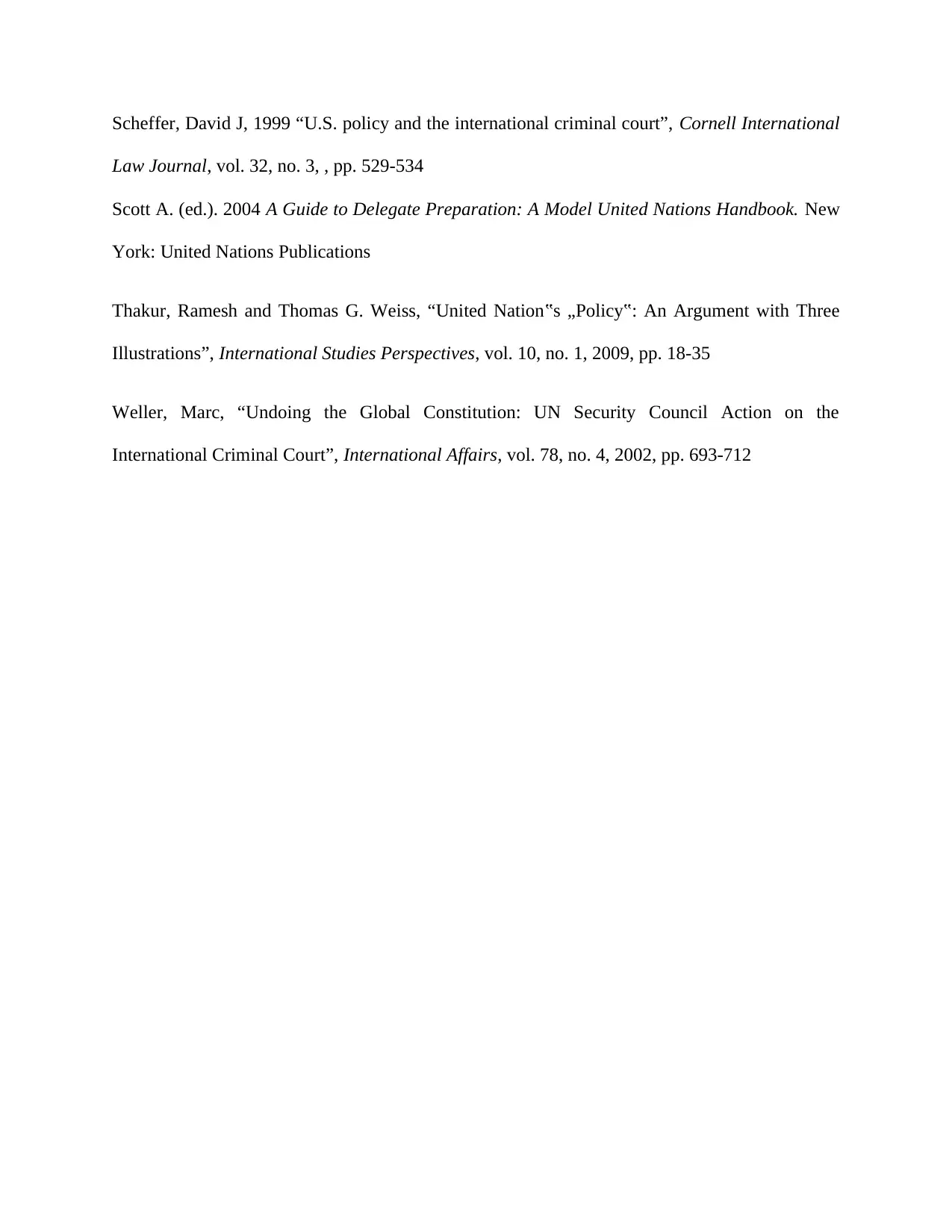
Scheffer, David J, 1999 “U.S. policy and the international criminal court”, Cornell International
Law Journal, vol. 32, no. 3, , pp. 529-534
Scott A. (ed.). 2004 A Guide to Delegate Preparation: A Model United Nations Handbook. New
York: United Nations Publications
Thakur, Ramesh and Thomas G. Weiss, “United Nation‟s „Policy‟: An Argument with Three
Illustrations”, International Studies Perspectives, vol. 10, no. 1, 2009, pp. 18-35
Weller, Marc, “Undoing the Global Constitution: UN Security Council Action on the
International Criminal Court”, International Affairs, vol. 78, no. 4, 2002, pp. 693-712
Law Journal, vol. 32, no. 3, , pp. 529-534
Scott A. (ed.). 2004 A Guide to Delegate Preparation: A Model United Nations Handbook. New
York: United Nations Publications
Thakur, Ramesh and Thomas G. Weiss, “United Nation‟s „Policy‟: An Argument with Three
Illustrations”, International Studies Perspectives, vol. 10, no. 1, 2009, pp. 18-35
Weller, Marc, “Undoing the Global Constitution: UN Security Council Action on the
International Criminal Court”, International Affairs, vol. 78, no. 4, 2002, pp. 693-712
1 out of 11
Related Documents
Your All-in-One AI-Powered Toolkit for Academic Success.
+13062052269
info@desklib.com
Available 24*7 on WhatsApp / Email
![[object Object]](/_next/static/media/star-bottom.7253800d.svg)
Unlock your academic potential
© 2024 | Zucol Services PVT LTD | All rights reserved.





